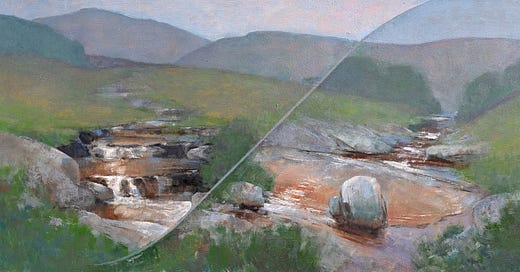Late last spring, I discovered a big piece (24"x48") of 1/8-inch birch plywood that I'd previously put aside and forgotten about. When I came across it just before leaving my winter studio for the summer, I cradled it, sealed it with with Gamblin's PVC sizing, slapped on two coats of acrylic gesso and then put it aside until my return, thinking I might make a nice painting on it some day. I stuck it in the back room, out of the way.
After my September trip to Scotland, I returned to the studio and started mulling over a variety of projects, including completing the obligation of making a series of small paintings for the patrons who supported the trip, as well as my new book. In the midst of these efforts, I opened the door to the back room—and there it was, the nicely cradled panel, waiting for inspiration. Yes, I'd forgotten about it again.
I kept the panel in mind as I finished up my other projects. What to paint on it? It needed something special.
One of my favorite outings on the Scotland trip was a sketching expedition into Glen Sannox on the Isle of Arran. The tourist literature claims that Arran is "Scotland in miniature," in that it contains the full diversity of the Scottish landscape on an island that measures a mere 20 by 10 miles, from lush forests and rolling hills in the south to highlands in the north. When I set foot on the trail, I found myself in a wild landscape: a graceful, narrow valley carved by ancient glaciers, its floor carpeted with heather and blaeberry, and edged with Scots pine and birches. The valley lay cradled between the massive, bald shoulders of the Arran Mountains, all swaddled in mist. I truly felt like I was in the Highlands.
[Quick commercial break: Although I use few mediums in my work, for this one I used Gamblin’s new 3-in-1 Medium. It’s called 3-in-1 because you can use it for prepping panels, underpainting or oiling out. For my practice, it has three additional, very useful properties: it helps make the paint more fluid so I can use broad, sweeping strokes for large areas, and it also helps the paint dry faster, allowing me to paint over areas for richer color and texture the very next day. I also find it handy for glazing areas where I want a more transparent area of paint, as in the warm, shadow areas of “Glen Sannox.” Now, back to our program already in progress.]
Keep reading with a 7-day free trial
Subscribe to Painting to See to keep reading this post and get 7 days of free access to the full post archives.




